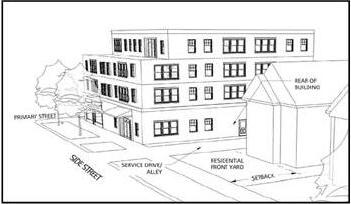A recent Chaddick Institute publication by John Hedrick, Senior Advisor, highlighted the current value of design guidelines.The key findings noted that more communities are using innovative and illustrated Design Guidelines to accomplish their goals of promoting quality design without adverse regulatory or economic consequences.
Background
Design Guidelines have been used world-wide of many centuries. In Illinois, there was a lull in implementation between Burnham's 1909 Plan of Chicago and the 1970's "appearance code" phenomena. Yet in this period, there was a steady evolution in the laws affecting aesthetic controls.
During the 1980's, there was a dramatic resurgence of interest in urban design. Design review had acquired a negative image in some circles due to perceptions that ordinances and reviews dwelled on superficial characteristics of buildings, such as materials and colors. As a result, the use of design guidelines became much more sophisticated. Guidelines are now much more detailed than they had been previously - and they are more comprehensive.

The overall purpose of guidelines is not to impose particular architectural details. Design guidelines help to fill the gap between general planning policies and specific zoning standards. Illustration Source: Glenview Form Based Code
Current Practices
This review of current practices indicates that design guidelines should at a minimum, address the following subjects: overall site design, building orientation, use of plant material and signage. The form for design guidelines depends upon the community, who will use them, and who will administer them. Typically, design guidelines are separate documents that supplement an ordinance or code. By being separate, guidelines explain better (and in more detail) just what qualities the community wants in its development. Ideally, the community can publish the guidelines in a format that clearly corresponds to the ordinance or code provisions.
The current generation of guidelines recognizes that pictorial images can be powerful as words in shaping development. While written language is still necessary, the use of photographs, sketches, and diagrams is becoming increasingly widespread to illustrate what is and is not acceptable.
Library of Design Guidelines
The Chaddick Institute is developing and maintaining an on-line library of design guidelines utilized by communities in the Chicago metropolitan area and throughout the state of Illinois. The codes/guidelines are available below for design review professionals and elected officials to explore and compare the wide variety of approaches employed by communities in our region.
Please keep in mind that the organizational approaches and formats vary widely. This reflects the diverse approaches used to promote public participation, utilize staff efforts and follow the guidance of consultants. In some instances the documents have been provided to us by the jurisdiction or professional consultants involved, while others have been obtained from the published municipal sources.
The Chaddick Institute does not currently endorse any particular approach or professional consultant, and the organization or titles are not intended to imply a preference. Moreover, any proprietary rights or attribution remain as noted in the documents. We seek to expand the library and invite you to send your community's design guidelines or firm profiles to MDRN@depaul.edufor inclusion in the list below.
In the future, the Chaddick Institute intends to work with the Municipal Design Review Network to assess and develop best practices and model provisions. This Library will be updated as such work proceeds. If you have any questions regarding these topics or projects, please contact us at MDRN@depaul.edu.
General Architectural Guidelines
Sign Guidelines/Codes